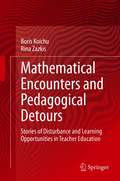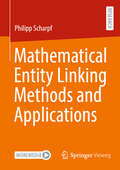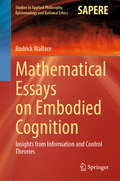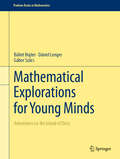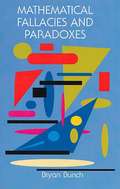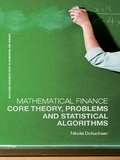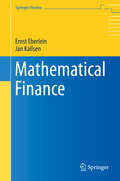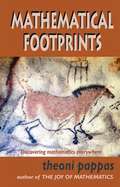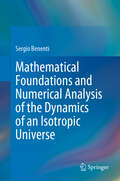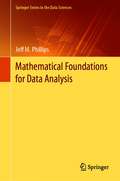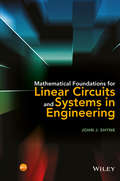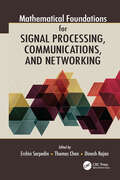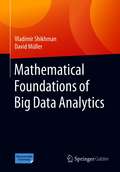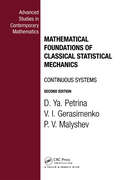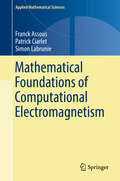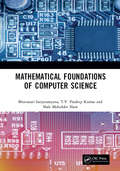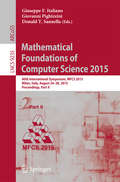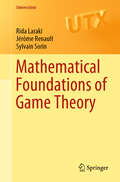- Table View
- List View
Mathematical Encounters and Pedagogical Detours: Stories of Disturbance and Learning Opportunities in Teacher Education
by Rina Zazkis Boris KoichuThis book explores the idea that mathematics educators and teachers are also problem solvers and learners, and as such they constantly experience mathematical and pedagogical disturbances. Accordingly, many original tasks and learning activities are results of personal mathematical and pedagogical disturbances of their designers, who then transpose these disturbances into learning opportunities for their students. This learning-transposition process is a cornerstone of mathematics teacher education as a lived, developing enterprise. Mathematical Encounters and Pedagogical Detours unfold the process and illustrate it by various examples. The book engages readers in original tasks, shares the results of task implementation and describes how these results inform the development of new tasks, which often intertwine mathematics and pedagogy. Most importantly, the book includes a dialogue between the authors based on the stories of their own learning, which triggers continuous exploration of learning opportunities for their students.
Mathematical Engineering of Deep Learning (Chapman & Hall/CRC Data Science Series)
by Benoit Liquet Yoni Nazarathy Sarat MokaMathematical Engineering of Deep Learning provides a complete and concise overview of deep learning using the language of mathematics. The book provides a self-contained background on machine learning and optimization algorithms and progresses through the key ideas of deep learning. These ideas and architectures include deep neural networks, convolutional models, recurrent models, long/short-term memory, the attention mechanism, transformers, variational auto-encoders, diffusion models, generative adversarial networks, reinforcement learning, and graph neural networks. Concepts are presented using simple mathematical equations together with a concise description of relevant tricks of the trade. The content is the foundation for state-of-the-art artificial intelligence applications, involving images, sound, large language models, and other domains. The focus is on the basic mathematical description of algorithms and methods and does not require computer programming. The presentation is also agnostic to neuroscientific relationships, historical perspectives, and theoretical research. The benefit of such a concise approach is that a mathematically equipped reader can quickly grasp the essence of deep learning.Key Features: A perfect summary of deep learning not tied to any computer language, or computational framework. An ideal handbook of deep learning for readers that feel comfortable with mathematical notation. An up-to-date description of the most influential deep learning ideas that have made an impact on vision, sound, natural language understanding, and scientific domains. The exposition is not tied to the historical development of the field or to neuroscience, allowing the reader to quickly grasp the essentials. Deep learning is easily described through the language of mathematics at a level accessible to many professionals. Readers from fields such as engineering, statistics, physics, pure mathematics, econometrics, operations research, quantitative management, quantitative biology, applied machine learning, or applied deep learning will quickly gain insights into the key mathematical engineering components of the field.
Mathematical Entity Linking Methods and Applications
by Philipp ScharpfThis research book explores the adaptation of traditional Entity Linking techniques to Mathematical Entity Linking (MathEL) for STEM disciplines, addressing the limitations of current Information Retrieval methods in handling mathematical expressions. By developing and evaluating novel MathEL approaches using AI, Machine Learning, and the Wikidata Knowledge Graph, significant progress is achieved in areas such as Formula Concept recognition, semantic formula search, mathematical question answering, physics exam question generation, and STEM document classification. The study also introduces a suite of open-source Wikimedia MathEL tools, including AnnoMathTeX, MathQA, and PhysWikiQuiz, designed to advance Mathematical Information Retrieval and support innovative applications in academic and educational contexts.
Mathematical Essays on Embodied Cognition: Insights from Information and Control Theories (Studies in Applied Philosophy, Epistemology and Rational Ethics #72)
by Rodrick WallaceThis book provides a unique formal foundation for the development of statistical tools useful in the exploration of observational and experimental data related to embodied cognition. The asymptotic limit theorems of information and control theories can be used to construct statistical tools analogous to -- but different from -- regression models for the study of the often highly punctuated cognitive phenomena embedded in and hence influenced by a surrounding ecosystem of which the phenomena are themselves part. The book builds probability models based on those theorems that incorporate embodiment at a number of scales and levels of organization, ranging from the effects of stress on the immune system within a higher organism, through institutional (and machine) cognition under challenge from adversaries, to the failure of public health institutions under pathogen challenge. In distinct contrast to the existing literature, many detailed, worked-out examples provide templates for sophisticated readers to build their own model/tool constructs.
Mathematical Explorations
by Alan F. BeardonMathematical Explorations follows on from the author's previous book, Creative Mathematics, in the same series, and gives the reader experience in working on problems requiring a little more mathematical maturity. The author's main aim is to show that problems are often solved by using mathematics that is not obviously connected to the problem, and readers are encouraged to consider as wide a variety of mathematical ideas as possible. In each case, the emphasis is placed on the important underlying ideas rather than on the solutions for their own sake. To enhance understanding of how mathematical research is conducted, each problem has been chosen not for its mathematical importance, but because it provides a good illustration of how arguments can be developed. While the reader does not require a deep mathematical background to tackle these problems, they will find their mathematical understanding is enriched by attempting to solve them.
Mathematical Explorations for Young Minds: Adventures on the Island of Oxisz (Problem Books in Mathematics)
by Gábor Szűcs Bálint Hujter Dániel LengerThis book presents a carefully curated selection of mathematical problems suitable for young minds aged 12 and beyond. Most of these problems have been adapted from the Dürer Competition, a venerable mathematics competition in Hungary renowned for fostering teamwork and encouraging creative thinking in the realm of mathematical problem-solving. Within the pages of this book, readers are invited to accompany Albrecht, Tarkal, and Zsordi on 14 captivating journeys to the enigmatic Island of Oxisz, where they will encounter a total of 84 thought-provoking problems. Some of these challenges are intricately interconnected, elevating the level of difficulty. The concluding section provides comprehensive solutions and helpful hints, illuminating the paths taken by the three friends to tackle the problems. No specialized prior knowledge is required beyond a solid foundation in mathematics from the first seven years of school. Nevertheless, many problems in the book demand original ideas or clever combinations of elementary principles. This book offers students, mathematics educators, and trainers alike a captivating glimpse into a distinctive competition, making it a valuable resource for cultivating problem-solving skills at an early age.
Mathematical Fallacies and Paradoxes
by Bryan BunchFrom ancient Greek mathematics to 20th-century quantum theory, paradoxes, fallacies and other intellectual inconsistencies have long puzzled and intrigued the mind of man. This stimulating, thought-provoking compilation collects and analyzes the most interesting paradoxes and fallacies from mathematics, logic, physics and language.While focusing primarily on mathematical issues of the 20th century (notably Godel's theorem of 1931 and decision problems in general), the work takes a look as well at the mind-bending formulations of such brilliant men as Galileo, Leibniz, Georg Cantor and Lewis Carroll - and describes them in readily accessible detail. Readers will find themselves engrossed in delightful elucidations of methods for misunderstanding the real world by experiment (Aristotle's Circle paradox), being led astray by algebra (De Morgan's paradox), failing to comprehend real events through logic (the Swedish Civil Defense Exercise paradox), mistaking infinity (Euler's paradox), understanding how chance ceases to work in the real world (the Petersburg paradox) and other puzzling problems. Some high school algebra and geometry is assumed; any other math needed is developed in the text. Entertaining and mind-expanding, this volume will appeal to anyone looking for challenging mental exercises.
Mathematical Finance: Core Theory, Problems and Statistical Algorithms
by Nikolai DokuchaevWritten in a rigorous yet logical and easy to use style, spanning a range of disciplines, including business, mathematics, finance and economics, this comprehensive textbook offers a systematic, self-sufficient yet concise presentation of the main topics and related parts of stochastic analysis and statistical finance that are covered in the majority of university programmes. Providing all explanations of basic concepts and results with proofs and numerous examples and problems, it includes: an introduction to probability theory a detailed study of discrete and continuous time market models a comprehensive review of Ito calculus and statistical methods as a basis for statistical estimation of models for pricing a detailed discussion of options and their pricing, including American options in a continuous time setting. An excellent introduction to the topic, this textbook is an essential resource for all students on undergraduate and postgraduate courses and advanced degree programs in econometrics, finance, applied mathematics and mathematical modelling as well as academics and practitioners.
Mathematical Finance: Deterministic and Stochastic Models (Wiley-iste Ser.)
by Jacques Janssen Raimondo Manca Ernesto VolpeThis book provides a detailed study of Financial Mathematics. In addition to the extraordinary depth the book provides, it offers a study of the axiomatic approach that is ideally suited for analyzing financial problems. This book is addressed to MBA's, Financial Engineers, Applied Mathematicians, Banks, Insurance Companies, and Students of Business School, of Economics, of Applied Mathematics, of Financial Engineering, Banks, and more.
Mathematical Finance: In Honour Of Ernst Eberlein (Springer Finance #189)
by Jan Kallsen Ernst EberleinTaking continuous-time stochastic processes allowing for jumps as its starting and focal point, this book provides an accessible introduction to the stochastic calculus and control of semimartingales and explains the basic concepts of Mathematical Finance such as arbitrage theory, hedging, valuation principles, portfolio choice, and term structure modelling. It bridges thegap between introductory texts and the advanced literature in the field.Most textbooks on the subject are limited to diffusion-type models which cannot easily account for sudden price movements. Such abrupt changes, however, can often be observed in real markets. At the same time, purely discontinuous processes lead to a much wider variety of flexible and tractable models. This explains why processes with jumps have become an established tool in the statistics and mathematics of finance. Graduate students, researchers as well as practitioners will benefit from this monograph.
Mathematical Financial Economics
by Igor V. Evstigneev Thorsten Hens Klaus Reiner Schenk-HoppéThis textbook is an elementary introduction to the key topics in mathematical finance and financial economics - two realms of ideas that substantially overlap but are often treated separately from each other. Our goal is to present the highlights in the field, with the emphasis on the financial and economic content of the models, concepts and results. The book provides a novel, unified treatment of the subject by deriving each topic from common fundamental principles and showing the interrelations between the key themes. Although the presentation is fully rigorous, with some rare and clearly marked exceptions, the book restricts itself to the use of only elementary mathematical concepts and techniques. No advanced mathematics (such as stochastic calculus) is used.
Mathematical Footprints
by Theoni PappasMATHEMATICAL FOOTPRINTS takes a creative look at the role mathematics has played since prehistoric times, and will play in the future, and uncovers mathematics where you least expect to find it from its many uses in medicine, the sciences, and its appearance in art to its patterns in nature and its central role in the development of computers. Pappas presents mathematical ideas in a readable non-threatening manner.MATHEMATICAL FOOTPRINTS is another gem by the creator of THE MATHEMATICS CALENDAR and author of THE JOY OF MATHEMATICS."Pappas's books have been gold mines of mathematical entertainment...spreading inspirational and mathematical good cheer. " - Jon Scieszka, author of Math Curse
Mathematical Foundations and Applications of Graph Entropy
by Matthias Dehmer Frank Emmert-Streib Xueliang Li Yongtang Shi Zengqiang ChenThis latest addition to the successful Network Biology series presents current methods for determining the entropy of networks, making it the first to cover the recently established Quantitative Graph Theory. An excellent international team of editors and contributors provides an up-to-date outlook for the field, covering a broad range of graph entropy-related concepts and methods. The topics range from analyzing mathematical properties of methods right up to applying them in real-life areas. Filling a gap in the contemporary literature this is an invaluable reference for a number of disciplines, including mathematicians, computer scientists, computational biologists, and structural chemists.
Mathematical Foundations and Numerical Analysis of the Dynamics of an Isotropic Universe
by Sergio BenentiThis book is an enhanced and expanded English edition of the treatise “Fondamenti matematici e analisi numerica della dinamica di un Universo isotropo,” published by the Accademia delle Scienze di Torino in volume no. 42-43, 2018-2019. The book summarizes some of the principal findings from a long-term cosmology research project, aiming to clarify significant results through clear mathematical postulates. Despite efforts, a single mathematical model accurately describing the universe’s evolution remains elusive due to early universe complexity and numerous observational parameters. Over the past century, various models have been proposed and discarded, illustrated by debates on the cosmological constant and spatial curvature assumptions. Currently, many models lack clear foundations, causing confusion in the field. Standard cosmological approaches rely on principles like Weyl’s principle, homogeneity, and isotropy, but may overlook discerning purely geometrical properties from those dependent on field equations. This book aims to bring order to cosmology by starting from understandable mathematical postulates, leading to theorems. Disagreements on postulates can prompt adjustments or alternative approaches. Physics often consists of deductive theories lacking explicit delineation of underlying concepts and postulates, a criticism relevant to cosmological theories. Despite a late 1990s consensus on the Lambda cold dark matter model, the absence of a logical-deductive structure in literature complicates understanding, leading some to humorously dub it the “expanding Universe and expanding confusion.”
Mathematical Foundations for Data Analysis (Springer Series in the Data Sciences)
by Jeff M. PhillipsThis textbook, suitable for an early undergraduate up to a graduate course, provides an overview of many basic principles and techniques needed for modern data analysis. In particular, this book was designed and written as preparation for students planning to take rigorous Machine Learning and Data Mining courses. It introduces key conceptual tools necessary for data analysis, including concentration of measure and PAC bounds, cross validation, gradient descent, and principal component analysis. It also surveys basic techniques in supervised (regression and classification) and unsupervised learning (dimensionality reduction and clustering) through an accessible, simplified presentation. Students are recommended to have some background in calculus, probability, and linear algebra. Some familiarity with programming and algorithms is useful to understand advanced topics on computational techniques.
Mathematical Foundations for Linear Circuits and Systems in Engineering
by John J. ShynkExtensive coverage of mathematical techniques used in engineering with an emphasis on applications in linear circuits and systems Mathematical Foundations for Linear Circuits and Systems in Engineering provides an integrated approach to learning the necessary mathematics specifically used to describe and analyze linear circuits and systems. The chapters develop and examine several mathematical models consisting of one or more equations used in engineering to represent various physical systems. The techniques are discussed in-depth so that the reader has a better understanding of how and why these methods work. Specific topics covered include complex variables, linear equations and matrices, various types of signals, solutions of differential equations, convolution, filter designs, and the widely used Laplace and Fourier transforms. The book also presents a discussion of some mechanical systems that mathematically exhibit the same dynamic properties as electrical circuits. Extensive summaries of important functions and their transforms, set theory, series expansions, various identities, and the Lambert W-function are provided in the appendices. The book has the following features: Compares linear circuits and mechanical systems that are modeled by similar ordinary differential equations, in order to provide an intuitive understanding of different types of linear time-invariant systems. Introduces the theory of generalized functions, which are defined by their behavior under an integral, and describes several properties including derivatives and their Laplace and Fourier transforms. Contains numerous tables and figures that summarize useful mathematical expressions and example results for specific circuits and systems, which reinforce the material and illustrate subtle points. Provides access to a companion website that includes a solutions manual with MATLAB code for the end-of-chapter problems. Mathematical Foundations for Linear Circuits and Systems in Engineering is written for upper undergraduate and first-year graduate students in the fields of electrical and mechanical engineering. This book is also a reference for electrical, mechanical, and computer engineers as well as applied mathematicians. John J. Shynk, PhD, is Professor of Electrical and Computer Engineering at the University of California, Santa Barbara. He was a Member of Technical Staff at Bell Laboratories, and received degrees in systems engineering, electrical engineering, and statistics from Boston University and Stanford University.
Mathematical Foundations for Signal Processing, Communications, and Networking
by Erchin Serpedin, Thomas Chen and Dinesh RajanMathematical Foundations for Signal Processing, Communications, and Networking describes mathematical concepts and results important in the design, analysis, and optimization of signal processing algorithms, modern communication systems, and networks. Helping readers master key techniques and comprehend the current research literature, the book offers a comprehensive overview of methods and applications from linear algebra, numerical analysis, statistics, probability, stochastic processes, and optimization. From basic transforms to Monte Carlo simulation to linear programming, the text covers a broad range of mathematical techniques essential to understanding the concepts and results in signal processing, telecommunications, and networking. Along with discussing mathematical theory, each self-contained chapter presents examples that illustrate the use of various mathematical concepts to solve different applications. Each chapter also includes a set of homework exercises and readings for additional study. This text helps readers understand fundamental and advanced results as well as recent research trends in the interrelated fields of signal processing, telecommunications, and networking. It provides all the necessary mathematical background to prepare students for more advanced courses and train specialists working in these areas.
Mathematical Foundations of Big Data Analytics
by David Müller Vladimir ShikhmanIn this textbook, basic mathematical models used in Big Data Analytics are presented and application-oriented references to relevant practical issues are made. Necessary mathematical tools are examined and applied to current problems of data analysis, such as brand loyalty, portfolio selection, credit investigation, quality control, product clustering, asset pricing etc. – mainly in an economic context. In addition, we discuss interdisciplinary applications to biology, linguistics, sociology, electrical engineering, computer science and artificial intelligence. For the models, we make use of a wide range of mathematics – from basic disciplines of numerical linear algebra, statistics and optimization to more specialized game, graph and even complexity theories. By doing so, we cover all relevant techniques commonly used in Big Data Analytics.Each chapter starts with a concrete practical problem whose primary aim is to motivate the study of a particular Big Data Analytics technique. Next, mathematical results follow – including important definitions, auxiliary statements and conclusions arising. Case-studies help to deepen the acquired knowledge by applying it in an interdisciplinary context. Exercises serve to improve understanding of the underlying theory. Complete solutions for exercises can be consulted by the interested reader at the end of the textbook; for some which have to be solved numerically, we provide descriptions of algorithms in Python code as supplementary material.This textbook has been recommended and developed for university courses in Germany, Austria and Switzerland.
Mathematical Foundations of Classical Statistical Mechanics
by D.Ya. Petrina V.I. Gerasimenko P V MalyshevThis monograph considers systems of infinite number of particles, in particular the justification of the procedure of thermodynamic limit transition. The authors discuss the equilibrium and non-equilibrium states of infinite classical statistical systems. Those states are defined in terms of stationary and nonstationary solutions to the Bogolyubov
Mathematical Foundations of Complex Networked Information Systems
by Chiara Ravazzi P. R. Kumar Martin J. Wainwright Riccardo Zecchinafabio Fagnani Sophie M. FossonIntroducing the reader to the mathematics beyond complex networked systems, these lecture notes investigate graph theory, graphical models, and methods from statistical physics. Complex networked systems play a fundamental role in our society, both in everyday life and in scientific research, with applications ranging from physics and biology to economics and finance. The book is self-contained, and requires only an undergraduate mathematical background.
Mathematical Foundations of Computational Electromagnetism (Applied Mathematical Sciences #198)
by Franck Assous Patrick Ciarlet Simon LabrunieThis book presents an in-depth treatment of various mathematical aspects of electromagnetism and Maxwell's equations: from modeling issues to well-posedness results and the coupled models of plasma physics (Vlasov-Maxwell and Vlasov-Poisson systems) and magnetohydrodynamics (MHD). These equations and boundary conditions are discussed, including a brief review of absorbing boundary conditions. The focus then moves to well‐posedness results. The relevant function spaces are introduced, with an emphasis on boundary and topological conditions. General variational frameworks are defined for static and quasi-static problems, time-harmonic problems (including fixed frequency or Helmholtz-like problems and unknown frequency or eigenvalue problems), and time-dependent problems, with or without constraints. They are then applied to prove the well-posedness of Maxwell’s equations and their simplified models, in the various settings described above. The book is completed with a discussion of dimensionally reduced models in prismatic and axisymmetric geometries, and a survey of existence and uniqueness results for the Vlasov-Poisson, Vlasov-Maxwell and MHD equations. The book addresses mainly researchers in applied mathematics who work on Maxwell’s equations. However, it can be used for master or doctorate-level courses on mathematical electromagnetism as it requires only a bachelor-level knowledge of analysis.
Mathematical Foundations of Computer Science
by Ashwin LallMathematical Foundations of Computer Science introduces students to the discrete mathematics needed later in their Computer Science coursework with theory of computation topics interleaved throughout. Students learn about mathematical concepts just in time to apply them to theory of computation ideas. For instance, sets motivate the study of finite automata, direct proof is practised using closure properties, induction is used to prove the language of an automaton, and contradiction is used to apply the pumping lemma. The main content of the book starts with primitive data types such as sets and strings and ends with showing the undecidability of the halting problem. There are also appendix chapters on combinatorics, probability, elementary number theory, asymptotic notation, graphs, loop invariants, and recurrences. The content is laid out concisely with a heavy reliance on worked examples, of which there are over 250 in the book. Each chapter has exercises, totalling 550. This class-tested textbook is targeted to intermediate Computer Science majors, and it is primarily intended for a discrete math / proofs course in a Computer Science major. It is also suitable for introductory theory of computation courses.The authors hope this book breeds curiosity into the subject and is designed to satisfy this to some extent by reading this book. The book will prepare readers for deeper study of game theory applications in many fields of study.
Mathematical Foundations of Computer Science
by Bhavanari Satyanarayana T.V. Pradeep Kumar Shak Mohiddin ShawPlease note: Taylor & Francis does not sell or distribute the Hardback in India, Pakistan, Nepal, Bhutan, Bangladesh and Sri Lanka
Mathematical Foundations of Computer Science 2015
by Giuseppe F Italiano Giovanni Pighizzini Donald T. SannellaThis two volume set LNCS 9234 and 9235 constitutes the refereed conference proceedings of the 40th International Symposium on Mathematical Foundations of Computer Science, MFCS 2015, held in Milan, Italy, in August 2015. The 82 revised full papers presented together with 5 invited talks were carefully selected from 201 submissions. The papers feature high-quality research in all branches of theoretical computer science. They have been organized in the following topical main sections: logic, semantics, automata, and theory of programming (volume 1) and algorithms, complexity, and games (volume 2).
Mathematical Foundations of Game Theory (Universitext)
by Sylvain Sorin Rida Laraki Jérôme RenaultThis book gives a concise presentation of the mathematical foundations of Game Theory, with an emphasis on strategic analysis linked to information and dynamics. It is largely self-contained, with all of the key tools and concepts defined in the text.Combining the basics of Game Theory, such as value existence theorems in zero-sum games and equilibrium existence theorems for non-zero-sum games, with a selection of important and more recent topics such as the equilibrium manifold and learning dynamics, the book quickly takes the reader close to the state of the art. Applications to economics, biology, and learning are included, and the exercises, which often contain noteworthy results, provide an important complement to the text.Based on lectures given in Paris over several years, this textbook will be useful for rigorous, up-to-date courses on the subject. Apart from an interest in strategic thinking and a taste for mathematical formalism, the only prerequisite for reading the book is a solid knowledge of mathematics at the undergraduate level, including basic analysis, linear algebra, and probability.
